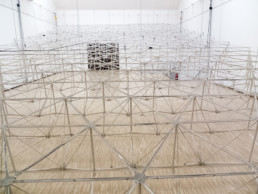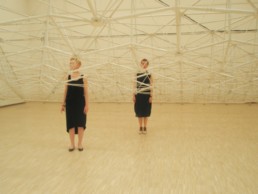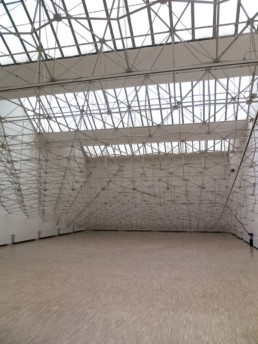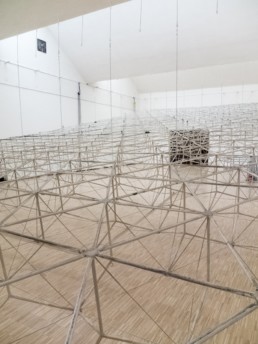The secret life of melted Air
sound sculpture
made especially for the exhibition W stronę instytucji krytycznej / Towards a Critical Institution
curators: Anna Czaban, Karolina Sikorska
The Arsenal Municipal Gallery, Poznań, 27 June–17 August 2016
An installation commissioned by the gallery during negotiations concerning a future of the institution with its organiser – The Municipal Office. It consisted in a decomposition of a suspended metal structure, situated beneath the exhibition space of the upper room of the gallery, and forming a filigree ceiling, with a skylight-covered, three-pitched roof over it, which was accompanied by a subtle sound of emergency.
The element of the interior employed by the artist, as well as the very interior, is a modernist and functionalist design by Jan Cieśliński, hidden behind a historicised facade by Zbigniew Zieliński – the architect alluding to the traditional architecture of the Old Market Square in Poznań, at the centre of which the gallery is located. The current seat of the municipal gallery had initially been intended as a department store, hence, the metal frame decorating its interior was to serve a purely practical function. The structure was disassembled on one side, in order to produce an impression of spontaneous breakage. The sound employed was generated by electronic components and simulated the noise of mechanism in breaking, an electric short-circuit, followed by silence.
The piece alludes to the SBS – sick building syndrome, which describes a set of ailments (e.g. fatigue, ill feeling) occurring at a given building, which, however, is not a recognised disease entity. The cause of an occurrence of the syndrome is a faulty air circulation, moving in a closed system of ventilation pipes and, concentrated, deposited on the walls, creating a welcoming environment for fungal and bacterial growth. Hundreds of exhaled words, smells as well as the body heat of employees present within are deposited in a system of hidden spaces of suspended ceilings, ventilation channels and walls, almost literally melting into the building’s architecture. The festering air construction pushes from within and successively bursts the physical structure.
The work can be regarded as belonging to the genre described as institutional critique and read as an attempt at a symbolic purification of the space. It was also a culmination of the social upheaval which shook the gallery in response to its attempted liquidation, and a symbolic disclosure of the tension not only at the junction of culture and public administration, but also within the very institution: a technical execution of the operation was initially met with resistance from the gallery management and a section of its employees, which adds another meaning to the artist’s activity: of the psychological mechanism of resisting change. Change which always requires something to be destroyed for another thing to be re-built. [description based on Ewa Toniak’s text for the exhibition and on curatorial texts]




